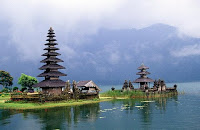
Why's Bali called the island of the thousand temples?
It is not surprising that Bali is called the island of the thousand temples. Everywhere you see a temple.
There are so many temples that the Government does not bother to count them. There are small temples, very small temples with only a very few shrines; there are large temples, very large temples with more than 50 shrines, such as the Temple of Besakih , the mother temple of Bali.
There are even lonely shrines on the oddest places where one does not expect them at all. Every family, every compound, every clan or society has a temple; you mention a society or organization and has a temple. In the compound where the family lives there is the family temple.
The desa, village itself must have at least three temples; Pura Puseh Pura desa and Pura Dalem The clan has its own temple.
Subak or irrigation organization has a temple, called Pura Subak or Pura Bedugul. Every place where the water to irrigate the rice field is divided has a temple or at least a shrine.
Bali has a whole has a temple, the pura Besakih or the mother temple, where every sect and nobility have their own temple. The balinese are worshippers of ancestors. The family does this in the family temple or house temple. The village does this in the Pura Puseh and all Bali does this in the temple of Besakih.
In South Bali the house temple is always in the North-East corner of the compound in regions South-West of Mount agung. The reason for this is that the top of Mount Agung is the highest spot in Bali and the highest is for God, Ida Sanghyang Widhi. Because the people should pray towards and God lives on the top of Mount Agung as the highest spot in Bali and Mount Agung happens to lie in the East that is why in South Bali the house temples is in the North-East corner of the compound. In North Bali it is the South-East corner where the house temple is built.
The number of shires in the house temple depends on the wish of the family and it also depends on where the family originally comes from. That is why the visitors in one house temple sees only a few shrines and in another, right next to it, much more. But in a house temple there must be at least two shrines, the �Sakti Kemulam� ; the Kemulan is for God and the purified ancestors and the Sakti is for the producing power of God. No matter how poor the compound is the house temple is there. This house temple can be very temporary built only of bamboo, but it can also be very elaborate; the shrines are very nicely carved and painted with gold leaves. Only the purified dead, that is to say the dead, who have been cremated, join God in the Kemulan shrine in the house temple.
With some high caste people the family makes a shrine for every ancestor who in his life had done a great service to the family, and accordingly in the house temple of such a family there are more than one ancestral shrine.
Near the entrance to a compound there is always a guardian shrine in front of or behind it; sometimes there are two shrines in front of it, flaking it. The guardian shrine is for the spirit that has to guard the primes. As told before a full-fledged village has to have at least three temples: Pura Puseh, where the founders of the village are worshiped, always lies in the Kaja sphere, towards the mountains, so it lies on the highest spot in the village; Lord Brahma the Creator, resides there.
Pura Desa, the village temple, is built in the center of the village, where Lord Wisnu, the maintainer, is worshipped, because in Pura Desa the activities of the village manifest to maintain the welfare of the village and its inhabitants.
In old societies, Pura Desa always has the Bale Agung, a long wooden building where the villagers monthly come together and sit to discuss village matters. The Bale agung is also the place where the Ngusabha ceremony, a ceremony to honor Dewi Sri, the rice Goddess is held.
Pura desa with a Bale agung is called Pura Bale Agung, because not every Pura Desa has a Bale agung.
In the Kelod share, towards the sea, so on the lowest part of the village, lies the cemetery. Near it the pura Dalem is built. This is the right place for Pura Dalem, because it is the temple of death or the temple for the dead. Of course Lord Siwa, the Destroyer, resides and is worshipped there.
The site of the three main temples is in accordance to the deep belief of the Balinese that the mountains are for god; the plains, the center of the country, are for the people and the sea, the lowest part of the country, is for the demonic forces.
Besides the three main temples there is the clan temple, called Pura Ibu, Pura Pemaksan or Pura Panti. Outside the village out in the rice fields, is the Subak temple, maintained by the organization of irrigation and farmers, where naturally Dewi Sri, the Rice Goddess is worshipped.





